Diplomatic Bluebook 2021
Chapter 4
Japan Strengthening Its Presence in the International Community
Section 3 Japan's International Cooperation (Development Cooperation and Response to Global Issues)
1 Development Cooperation
(1) Development Cooperation Charter and Japan's ODA Performance
More than 65 years have passed since Japan started its Official Development Assistance (ODA)1 in 1954. Japan's development cooperation policy including ODA has greatly contributed to securing peace, stability and prosperity of the international community and consequently the national interests of Japan for many years.
In recent years, the situation surrounding development is transforming, as indicated by the growing diversity and complexity of the issues facing development countries and the growing roles of non-ODA funds and support. In response to the transformation, in February 2015, the Development Cooperation Charter was decided by the Cabinet to replace its previous ODA Charter. Under the Development Cooperation Charter, taking into account its philosophy toward development cooperation cultivated over many years and from the perspective of further evolving this philosophy, Japan has established the basic policies of (1) contributing to peace and prosperity through cooperation for non-military purposes; (2) promoting human security; and (3) cooperation aimed at self-reliant development through assistance for self-help efforts as well as dialogue and collaboration based on Japan's experience and expertise. Japan promotes development cooperation under these basic policies, with (1) “quality growth” and poverty eradication through such growth; (2) sharing universal values and realizing a peaceful and secure society; and (3) building a sustainable and resilient international community through efforts to address global challenges.
Under this Development Cooperation Charter, in 2019, Japan provided approximately 15.59 billion US dollars (+10.1% year on year) in ODA2, based on the grant equivalent system (GE system)3 introduced by the Organisation for Economic Co-operation and Development's Development Assistance Committee (OECD/DAC) since 2018 data as the standard method for calculating ODA. Japan ranks fourth among the member states of the DAC, following the U.S., Germany and the UK. The ODA/GNI ratio based on the GE system was 0.30%, placing Japan in 13th place among member states of the DAC. In terms of gross disbursements4, Japan's ODA rose by 9.7% year on year to approximately 18.92 billion US dollars, once again ranking fourth after the U.S., Germany and the UK.
- 1 Official Development Assistance (ODA): For details on Japan's international cooperation, refer to “White Paper on Development Cooperation: Japan's International Cooperation.”https://www.mofa.go.jp/policy/oda/page_000017.html

- 2 The main modalities of ODA from Japan are: grant aid, namely, bilateral fund donations; loan aid, namely, loan for development in developing regions; technical cooperation; and donations or contributions to international organizations. Of these, loan aid accounts for the largest share. Loan aid is typically repaid with interest.
- 3 The Grant Equivalent system (GE system) calculates ODA loans based on the amount that is equivalent to the grant. The grant equivalent is calculated by applying the terms of the loan, such as amount disbursed, interest rate and maturity, to a formula. The softer the terms of the loan are, the larger the amount will be. Compared to the net flow system (the full amount of loan disbursement is included, but the amount repaid is calculated as a negative figure) that has conventionally been used as the standard method of the OECD/DAC, the GE system reflects Japan's loan aid more accurately.
- 4 The total amount Japan contributed as ODA during the year in question (without deductions of amounts repaid by the beneficiary country to Japan during the year in question for loans borrowed in the past)
(2) Development Cooperation in 2020
In 2020, Japan engaged mainly in the following (A to D below) in order to promote strategic and effective development cooperation, with the Development Cooperation Charter positioned at the core of these actions.
A Countermeasures against COVID-19
First, combating the novel coronavirus disease (COVID-19) marked a major challenge for the international community in 2020. The pandemic crossed national borders and became a global crisis. Countermeasures require the cooperation of the international community and not just the initiatives of individual countries and regions. With this belief in mind, Japan has provided health and medical equipment, and also technical cooperation for reinforcing capacities in the health and medical fields at an unprecedented speed in order to build a resilient medical and health system from a medium- to long-term standpoint in developing countries with vulnerable medical systems, through bilateral cooperation and international organizations. Furthermore, Japan has been providing the COVID-19 Crisis Response Emergency Support Loan up to 500 billion Japanese yen over two years to contribute to maintaining and revitalizing economic activities in developing countries. Japan's assistance has been lauded by other countries and key figures from other countries have directly stated their appreciation for this assistance to Prime Minister Suga and Foreign Minister Motegi during their visits.
Japan will continue to provide assistance toward vaccines, treatments and diagnostics for overcoming the current COVID-19 pandemic. Japan will also offer assistance for health security in a broad range of fields including water and sanitation and for improving health and medical systems in developing countries in preparation for future health crises.
B Achievement of a Free and Open Indo-Pacific (FOIP)
Second, Japan is promoting concrete initiatives utilizing ODA strategically in order to achieve a “Free and Open Indo-Pacific” (FOIP) in the Indo-Pacific region which is a focal point of the world's vitality.
Over the years, Japan has developed “quality infrastructure” for building regional connectivity, assisted in legal system development, offered training on public debt and risk management for ensuring debt sustainability, and capacity building for debt management and macroeconomic policy, and for maritime law enforcement agencies for securing safety at sea (provision of patrol vessels and coastal monitoring radars as well as human resources development, etc.). Japan will continue to offer these in the future.
The development of “quality infrastructure” is an important foundation for achieving FOIP and is particularly necessary in the recovery from the COVID-19 pandemic. From this standpoint, it is important to continue to disseminate and implement the G20 Principles for Quality Infrastructure Investment, endorsed at the G20 Osaka Summit of 2019 as an international standard, including such principles as openness, transparency, economic efficiency in view of life-cycle costs, and debt sustainability. In November 2020, Japan co-hosted the Symposium on Quality Infrastructure Investment together with the OECD, where it stated that it will actively play a role in helping the international community to build back better from the COVID-19 pandemic, while touching upon the utility of the OECD Compendium of Policy Good Practices for Quality Infrastructure Investment compiled by the OECD in the same month.
C Addressing Global Challenges
Third, Japan is working to address global challenges such as achieving the Sustainable Development Goals (SDGs), including combating COVID-19, based on the concept of human security.
Japan will continue to actively promote development cooperation in fields such as health, food, nutrition, women (gender), education, disaster risk reduction, water and hygiene, climate change and global environmental issues. In doing so, Japan will promote visible development cooperation while utilizing collaboration with NGOs working on international cooperation. In addition, Japan will continue to promote humanitarian assistance including support for refugees, peace building and nation building assistance based on the concept of “humanitarian-development-peace (HDP) nexus” to reinforce responses to fundamental causes of conflict, in addition to humanitarian assistance and development.
D Diplomatic Efforts in Support of Japan's Economy
Fourth, Japan seeks to revitalize its own economy through the development of developing countries and Japan is promoting initiatives for achieving the growth of both. The “Infrastructure System Overseas Promotion Strategy 2025” approved in December 2020 and “Follow-up on the Growth Strategy” approved in July 2020 call for utilizing ODA strategically to further encourage the overseas expansion of Japanese companies.
Specifically, in order to have Japan's leading technologies utilized for development in developing countries, Japan will promote the acquisition of business rights and operation rights of Japanese corporations through means such as the provision of grant aid for public projects implemented through public-private partnership and offer technical cooperation that contributes to quality infrastructure investment, such as trade facilitation and securing debt sustainability. Additionally, to encourage the overseas expansion of private companies including SMEs and local governments, Japan will increase the visibility of products and equipment that can help resolve issues in developing countries as well as continuously generate demand for these, and promote overseas expansion assistance for micro-, small- and medium-sized enterprises in the construction industry, including in local regions. Through human resource development, Japan will also contribute to advancing the improvement of the business environment, thereby promoting investment and overseas expansion by corporations.
(3) Safety Measures for Personnel Engaged in International Cooperation Projects
Amidst this approach to development cooperation, personnel engaged in international cooperation projects were heavily impacted by the COVID-19 pandemic in 2020. From mid-March, the Japan International Cooperation Agency (JICA) temporarily repatriated staff excluding managerial staff such as chief representatives and senior representatives of its overseas offices and many company officials also returned to Japan temporarily. Japan's diplomatic missions and JICA's overseas offices actively helped these Japanese nationals leave their respective countries. JICA has been resending its staff to countries that meet certain conditions since mid-July.
Japan will continue to strengthen safety measures for international cooperation projects further while fully implementing safety measures for personnel engaged in international cooperation projects in terms of preventing the spread of COVID-19 infections and engaging in initiatives based on the final report of the Council on Safety Measures for International Cooperation Projects (August 2016) which focused on counter-terrorism measures.
(4) Initiatives in Major Regions
A East and Southeast Asia
The East and Southeast Asia regions are important to the achievement of FOIP, and the peace, stability, and prosperity in the region are important to Japan, which has a close relationship with the region. Through development cooperation, Japan has helped these regions to resolve various development issues including poverty reduction, by promoting economic growth and human security and contributed to the development of these regions.
Approximately 61.1% of the total bilateral ODA of Japan went to the Asia region in 2019. A large portion of it comprised of support for Member States of the Association of Southeast Asian Nations (ASEAN). Japan not only provides support toward efforts aimed at overcoming issues faced by ASEAN and further promoting integration, but also places a strong emphasis on support for the building of quality infrastructure and training of industrial human resources to strengthen regional connectivity and develop industrial foundation.
Japan's support for the East and Southeast Asian regions was concentrated on measures against COVID-19 because of the large number of Japanese companies doing business there and the large resident population of Japanese nationals. Specifically, Japan provided a total of approximately 23 billion Japanese yen in health- and medical-related equipment to ten countries and is supporting assistance for improving health and medical systems in these countries through technical cooperation. Additionally, Japan provided fiscal support yen loans totaling approximately 295 billion Japanese yen to five countries to offset the economic impacts of the pandemic. At the Japan-ASEAN Summit Meeting held in November, a declaration was made that Japan will fully support the establishment of the ASEAN Centre for Public Health Emergencies and Emerging Diseases as part of its support to ASEAN during the pandemic.
Japan is also advancing cooperation to support initiatives aimed at strengthening the centrality and unity of ASEAN. At the Japan-ASEAN Summit Meeting held in November, the Japan-ASEAN Connectivity Initiative was launched focusing on quality infrastructure projects totaling two trillion Japanese yen that are already underway. It was announced that through this infrastructure development, the initiative will enhance connectivity in land, sea and air corridors and develop 1,000 human resources over a three-year period. Based on the Japan-ASEAN Technical Cooperation Agreement signed in 2019, Japan provided training on logistics, port administration and measures to combat marine plastics.
Furthermore, Japan is actively providing support for capacity building for maritime law enforcement to ASEAN countries positioned along Japan's sea lanes such as the Philippines and Viet Nam, with the aim of building the free and open international order. Such efforts include providing equipment such as patrol vessels and coastal monitoring radars, as well as human resource development through the dispatch of experts. In addition, Japan is providing consistent support to eradicate domestic and regional disparity, and support for the creation of a sustainable society in areas such as disaster risk reduction, environment and climate change, and energy. At the Japan-ASEAN Summit Meeting held in November, the Joint Statement of the 23rd ASEAN-Japan Summit on Cooperation on the ASEAN Outlook on the Indo-Pacific (AOIP) was announced. Based on the fact that it was confirmed that the principles of the AOIP and FOIP match one another, Japan plans to continue strengthening Japan-ASEAN cooperation going forward in terms of maritime cooperation, connectivity, the SDGs and economy, which are priority fields of the AOIP.
In the Mekong region, steady progress has been made with cooperation under the “Tokyo Strategy 2018,” a set of guidelines for Japan-Mekong cooperation. At the Mekong-Japan Foreign Ministers' Meeting held in July, Foreign Minister Motegi announced the “KUSANONE Mekong SDGs Initiative” and stated that Japan will support socioeconomic development and achievement of the SDGs through grassroots efforts in the Mekong region. Under this initiative, Japan provided grant aid for grassroots human security projects in the amount of one billion Japanese yen to five countries in the Mekong region in FY2020. At the Japan-Mekong Summit Meeting held in November, as one of the “five forms of cooperation,” the “Mekong SDGs Investment Partnership” was announced in order to support the implementation of development projects by private companies amid the shortfall of development funds following the economic blow suffered by Mekong region countries at the hands of COVID-19. Under this partnership, Japan will promote the formation of overseas investment projects in the Mekong region. Japan has also been working on projects such as the development of Sihanoukville port in Cambodia and functional improvements at Wattay International Airport in Laos and will continue to contribute to enhancing connectivity in the Mekong region under “Tokyo Strategy 2018.”
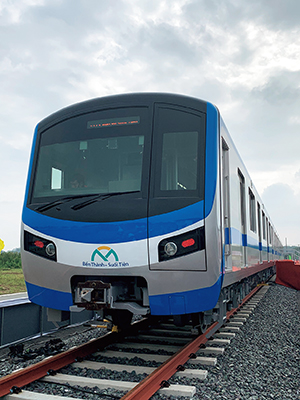 The first train arriving in the Ho Chi Minh City Urban Railway Construction Project (Line 1) (October, Viet Nam)
The first train arriving in the Ho Chi Minh City Urban Railway Construction Project (Line 1) (October, Viet Nam)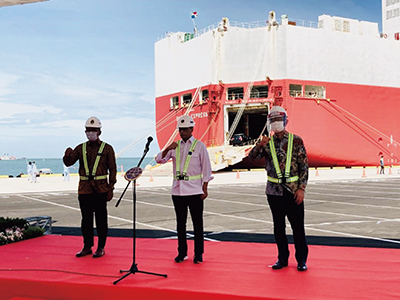 Ceremony to mark the partial completion, Patimban Port Development Project (December, Indonesia)
Ceremony to mark the partial completion, Patimban Port Development Project (December, Indonesia)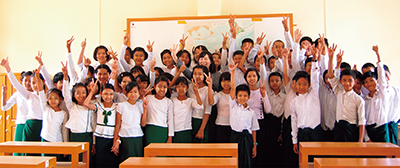 Elementary school building construction support provided through Grant Assistance for Grassroots Human Security Projects (Myanmar)
Elementary school building construction support provided through Grant Assistance for Grassroots Human Security Projects (Myanmar)B Southwest Asia
Southwest Asia holds strategic importance as a marine transportation hub that connects East Asia with the Middle East, and is also a region with immense economic potential, such as India, where economic growth and massive infrastructure demand are anticipated in the future. On the other hand, the region still faces many unresolved challenges such as undeveloped infrastructure, poverty and natural disasters. Japan provides a range of assistance through ODA to assist the region in overcoming these challenges, bearing in mind the improvement of the investment environment for Japanese companies, and ensuring human security. The worldwide COVID-19 pandemic has also had a substantial impact on Southwest Asia due to its social and economic vulnerabilities along with an underdeveloped medical system. As a measure against COVID-19 in Southwest Asian countries, Japan has provided health- and medical-related equipment to seven countries, totaling five billion Japanese yen, and assisted in the enhancement of health and medical systems through JICA's technical cooperation as well as through international organizations. In addition, Japan has provided a total of 120 billion Japanese yen in fiscal assistance yen loans to three countries, taking into account the economic impacts from the pandemic.
India, which has the largest population in Southwest Asia, has been one of the largest recipients of Japanese yen loans. As part of its support for the development of economic and social infrastructure including electricity and transportation infrastructure that contribute to enhancing connectivity and strengthening industrial competitiveness, Japan has assisted with the construction of subways in a number of cities and road construction in India's northeast. In addition, Japan has supported India's sustainable and inclusive growth through such projects as those in the forestry sector including afforestation activities as well as those in the health sector that help improve health and medical services for women and children.
With regard to Bangladesh, Japan, under the Bay of Bengal Industrial Growth Belt (BIG-B) initiative, has provided support which contributes to strengthening domestic and regional connectivity, developing infrastructure, and improving the investment environment. A large-scale influx of displaced persons from northern Rakhine State, Myanmar, and prolonged evacuation have resulted in the deterioration of humanitarian situations in camps for displaced persons and has also had a severe impact on the living environment of the surrounding host communities. In response to this situation, Japan provided support through international organizations and NGOs in the areas of water and hygiene, health and medical care, food security, livelihood assistance, education and environmental conservation.
In Sri Lanka, Japan provided equipment for countermeasures against illegal drugs and food aid for improving children's nutrition in partnership with the World Food Programme (WFP).
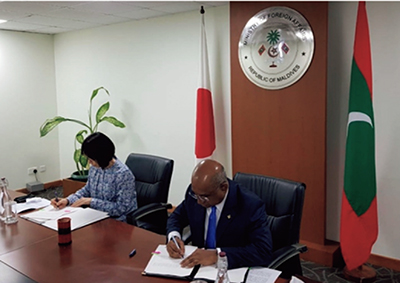 Signing Ceremony of the Exchange of Notes for Grant Aid aimed at supporting measures against COVID-19 (June 7, Malé, Maldives; Photo: Ministry of Foreign Affairs of Maldives)
Signing Ceremony of the Exchange of Notes for Grant Aid aimed at supporting measures against COVID-19 (June 7, Malé, Maldives; Photo: Ministry of Foreign Affairs of Maldives)C Pacific Island Countries
In addition to being Japan's neighbors connected by the Pacific, the Pacific Island countries also share deep historical ties with Japan. Moreover, as these countries possess a vast exclusive economic zone (EEZ, or waters over which a country's economic rights extends), they are a key region for Japan's maritime transportation, and provide vital fishing grounds for Japan's distant-water bonito and tuna fisheries. As such, the stability and prosperity of the Pacific Island countries are of great importance to Japan.
The Pacific Island countries share common issues that are unique to small island states, such as smaller economies that are dependent upon primary industries, territories that are scattered over a wide ocean area, difficulty in breaking into the international market, and vulnerability to damages from natural disasters. In light of these circumstances, Japan, as a good partner of the Pacific Island countries, is providing support to boost their autonomous and sustainable development.
At the 8th Pacific Islands Leaders Meeting (PALM8) held in Iwaki City, Fukushima Prefecture, in May 2018, with the pillars of (i) free, open and sustainable oceans; (ii) strengthening the foundations for resilient and sustainable development; and (iii) revitalization of people-to-people exchanges, and based on the achievement so far, Japan announced its commitment to continuing robust development assistance as before in keeping with the achievement so far. Japan also announced to further strengthen human resource development and exchanges (5,000 people over a three-year period), which are the foundation for growth and prosperity. Steady progress is being made with cooperation based on this policy. Japan is implementing concrete initiatives such as bilateral cooperation on basic infrastructure such as ports and airports as well as technical cooperation targeting multiple countries in areas such as illegal, unreported and unregulated fishing (IUU), disaster risk reduction, waste management that contributes to measures against marine plastic waste, and climate change issues.
However, the COVID-19 pandemic limited the movements of people and goods, causing a major economic blow to the Pacific Island countries. Japan has provided a total of four billion Japanese yen in health- and medical-related equipment and support for improving health and medical systems through technical cooperation in order to assist the Pacific Island countries in combating COVID-19. Japan also approved fiscal assistance yen loans amounting to a total of 42.5 billion Japanese yen for Papua New Guinea, Fiji and the Solomon Islands in order to support the economic recovery.
In October, the PALM Ministerial Interim Meeting for PALM9 was held. The Pacific Island countries stated their strong praise and deep appreciation to Japan for steadily implementing its commitment to support in all the fields designated as pillars of cooperation at PALM8.
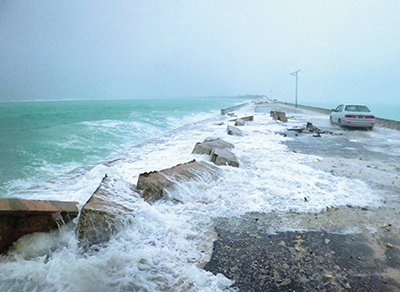 Before and after the Project for Reconstruction of the Nippon Causeway (Kiribati; Photo: Dai Nippon Construction Co., Ltd.) Before reconstruction
Before and after the Project for Reconstruction of the Nippon Causeway (Kiribati; Photo: Dai Nippon Construction Co., Ltd.) Before reconstruction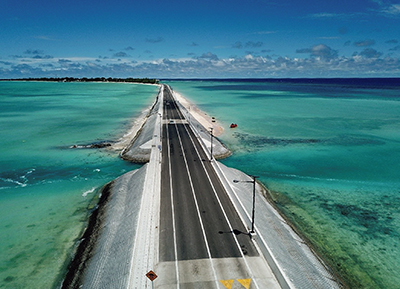 Before and after the Project for Reconstruction of the Nippon Causeway (Kiribati; Photo: Dai Nippon Construction Co., Ltd.) After reconstruction
Before and after the Project for Reconstruction of the Nippon Causeway (Kiribati; Photo: Dai Nippon Construction Co., Ltd.) After reconstructionD Latin America and the Caribbean
Latin America and the Caribbean is a region with which Japan has enjoyed friendly relations for a long time. The region also has deep historical ties with Japan, as demonstrated by the fact that more than 2 million Japanese descendants, known as “Nikkei,” reside in the region. The region is a major supplier of resources and food, as well as a potential emerging market with gross regional production exceeding 5.5 trillion US dollars. On the other hand, as many countries in the region are facing challenges such as rectification of income inequality within country, response to natural disasters, and achievement of the SDGs in each country, Japan is engaged in various cooperative efforts while also taking into account the circumstances of each country in Latin America and the Caribbean.
Japan is providing health- and medical-related equipment to 18 countries in Latin America, totaling 7.9 billion Japanese yen, to help combat the COVID-19 pandemic. In addition, Japan is also providing assistance to 17 countries through JICA's technical cooperation for the improvement of health and medical systems in those countries as well as providing assistance to this region through international organizations.
Additionally, in response to the hurricane-related damages in November, Japan provided emergency aid supplies (tents, sleeping pads and blankets) to Colombia, Nicaragua, Honduras and Guatemala. Japan also provided support based on the needs of each country; for example, Japan offered food aid to Haiti, which faces serious famine, and provided algae removal equipment to Small Island Developing States (SIDS) (Antigua and Barbuda as well as Grenada) experiencing substantial impacts to marine fisheries and tourism industries due to the accumulation and decay of sargassum seaweed along their shorelines.
In recent years, there have been concerns over the increase in the number of migrants from Central American countries to the United States, which results in deterioration of public security. As such, alleviating poverty, one of the causes of migration, has become an urgent issue that has to be addressed. Japan provided assistance through the International Organization for Migration (IOM) and WFP, to Guatemala and Honduras to curtail immigration and emigration caused by economic distress and to reintegrate migrants in communities to which they return. Recently, deterioration in social and economic conditions in Venezuela has also resulted in a large number of displaced persons. In response to this, in Peru, Japan is working with the IOM to provide food support and vocational training to displaced persons, and capacity building to Peru, which has accepted displaced persons. In Venezuela, Japan partnered with the United Nations Children's Emergency Fund (UNICEF) to provide assistance to increase access to regular vaccinations of children and expectant mothers.
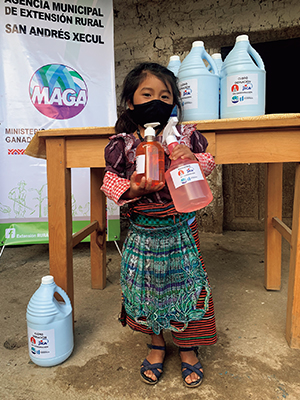 “Hand-washing COVID-19 (novel coronavirus disease) countermeasure training” in Totonicapan Department (September 22, Guatemala; Photo: JICA)
“Hand-washing COVID-19 (novel coronavirus disease) countermeasure training” in Totonicapan Department (September 22, Guatemala; Photo: JICA)E Central Asia and Caucasus
Central Asia and Caucasus are surrounded by Russia, China, South Asia, the Middle East and Europe. The stability and development of this region are also important for the development and stability of the whole of Eurasia, including Japan. Japan supports the “open, stable, and self-sustained” development of Central Asia and the Caucasus region. Japan supports nation building that allows fundamental values such as human rights, democracy, market economy and the rule of law to take root for long-term stability and sustainable development in this region, while also taking into account broad-based views covering neighboring regions including Afghanistan and Iran.
Japan is providing health- and medical-related equipment to six countries, totaling 2.5 billion Japanese yen, as a measure against COVID-19 in Central Asia and Caucasus. In addition, Japan is providing support to three countries for improving health and medical systems through JICA's technical cooperation as well as providing assistance to this region through international organizations. During the Foreign Ministers' Special Video Conference of the “Central Asia plus Japan” Dialogue in August, Foreign Minister Motegi stated that as measures against COVID-19 in this region, Japan is actively providing health and medical equipment, technical support through international organizations, provision of Avigan tablets, and exchange of opinions among medical professionals among others, so as to support the initiatives of respective countries.
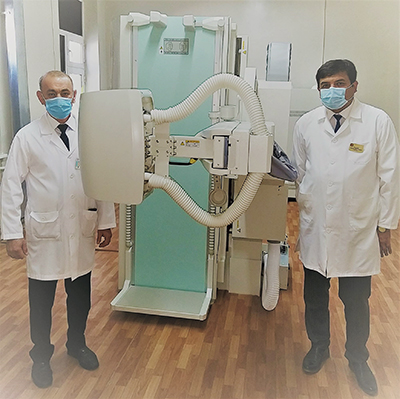 X-ray diagnostic system provided to the Tashkent Region Cancer Clinic (September 10, Uzbekistan; Photo: JICA)
X-ray diagnostic system provided to the Tashkent Region Cancer Clinic (September 10, Uzbekistan; Photo: JICA)F The Middle East and North Africa
Securing peace and stability in the Middle East and North Africa regions, which are the geopolitical keys, is crucial not only for the energy security of Japan but also for the stability of the world. From this point of view, Japan provided comprehensive support until 2018 at a sum of about 6 billion US dollars to stabilize the Middle East, including human resource development for about 20,000 people, as it announced at the G7 Ise-Shima Summit (2016), with a view to achieving peace and stability in the region. Thereafter, Japan is still continuing to provide support to the Middle East and North Africa.
In 2020, Japan provided COVID-19-related support to the Middle East and North Africa regions using ODA. Specifically, Japan earmarked a total of around 13.4 billion Japanese yen for support through international organizations, provided health- and medical-related equipment as bilateral assistance, and offered a loan to improve the health and medical system to Morocco.
With regard to Syria, where civil war has been prolonged, Parliamentary Vice-Minister for Foreign Affairs Nakatani Shinichi participated in Supporting the future of Syria and the region, Brussels IV Conference, co-organized by the EU and UN in June 2020. Under its policy of providing humanitarian assistance to all Syrians facing difficulties, Japan has provided more than 2.9 billion US dollars to Syria and surrounding countries since 2012, and Parliamentary Vice-Minister for Foreign Affairs Nakatani stated that Japan will continue to fulfill the role in improving the humanitarian situation in Syria going forward. Furthermore, in order to foster human resources who could contribute to Syria's future reconstruction, 95 Syrian students have been accepted in Japan since 2017.
In regard to Palestine, based on the Corridor for Peace and Prosperity initiative with the aim of promoting economic and social development for Palestine promoted through cooperation between Japan, Israel, Palestine and Jordan, Japan assists the development of Jericho Agro-Industrial Park (JAIP). Parliamentary Vice-Minister for Foreign Affairs Suzuki Keisuke attended the Ad Hoc Liaison Committee (AHLC) Ministerial Meeting held in June, where he stated that Japan will continue to create an environment for peace in the Middle East by promoting its own unique initiatives.
In Yemen, where a severe humanitarian crisis is still ongoing, Japan has provided more than 300 million US dollars in support since 2015. At the High-Level Pledging Event for the Humanitarian Crisis in Yemen held in June, Parliamentary Vice-Minister for Foreign Affairs Suzuki stated that Japan will continue its support. Additionally, in 2020, Japan continued to offer humanitarian assistance and provided cooperation in the field of mental healthcare through partnerships with international organizations.
In Afghanistan, where the reconstruction progresses, peace negotiations were initiated in September. Japan has provided assistance to encourage the independent economic growth and poverty reduction in the country. At the 2020 Geneva Conference on Afghanistan held in November, Foreign Minister Motegi welcomed the start of peace negotiations and pledged to maintain annual support of 180 million US dollars, the same level as the previous four years, for the next four years on the condition that Afghanistan make progress in reforms. He also stated that Japan prepares to examine additional assistance if progress is seen in the peace process.
Human resource development is vital to realize stability in the Middle East in the medium- to long-term. As one example, through the technical cooperation project “Egypt-Japan University of Science and Technology (E-JUST) Project Phase 3,” Japan is providing support for the development of industrial human resources as well as science and technology human resources in Egypt, the Middle East and the Africa region. The scholarship program for accepting international students from Africa has been expanded since 2020.
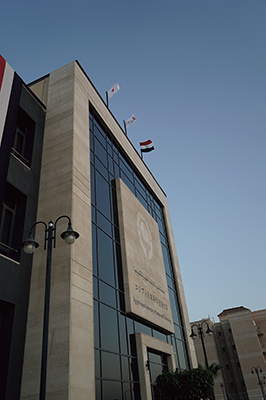
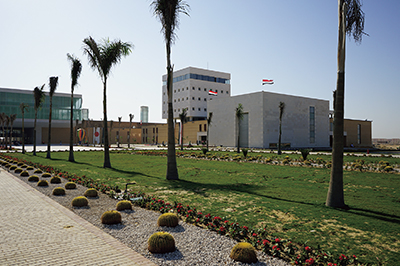 Exterior view of E-JUST with establishment of new faculties under Japan's support in progress (November, Egypt; Photo: JICA)
Exterior view of E-JUST with establishment of new faculties under Japan's support in progress (November, Egypt; Photo: JICA)G Africa
Africa has been gradually recovering from the economic depression caused by the rapid drop in natural resource prices around 2014, and continues to attract the attention and anticipation from the international community for its potential, backed by its abundant natural resources and a rapidly growing population. On the other hand, the COVID-19 pandemic has shed light on Africa's fragilities in various areas including healthcare and medical sectors. In these circumstances, Japan has provided healthcare and medical equipment to 48 out of 54 African countries through bilateral arrangements as well as collaborations with international organizations, and has made a total donation of 14.8 billion Japanese yen in healthcare and medical equipment to 38 of those countries. Japan also provided assistance through technical cooperation for strengthening the healthcare and medical system in Africa. In addition, through the longstanding process of Tokyo International Conference on African Development (TICAD), Japan has actively implemented programs to support the healthcare and medical system in Africa in a medium- to long-term perspective. These efforts have proven their true value as COVID-19 spread in Africa. The Noguchi Memorial Institute for Medical Research in Ghana for which Japan has supported the establishment and cooperated in training laboratory technicians, was responsible for up to 80% of the PCR tests in the country. Likewise, other healthcare and medical research institutes that have received assistance from Japan, such as the Kenya Medical Research Institute (KEMRI), are performing as a center for countermeasures against COVID-19 throughout Africa. Japan's support on healthcare and medical sectors has also borne fruit in areas other than COVID-19 measures. For example, as Nigeria was declared wild poliovirus-free in August, Japan had, to this end, conducted a wide range of assistance from vaccine procurement to human resources development in improving response to eradicating polio, for which the Nigerian President Muhammadu Buhari also extended his appreciation.
COVID-19 also has a widespread impact on the African society and economy. Japan is implementing measures under each of the three pillars of TICAD7 held in August 2019: economy, society, and peace and stability, making contribution to respond to the various social and economic issues in Africa.
In the pillar of Economy, Japan has promoted industrial human resource development through the African Business Education Initiative for Youth (ABE initiative) 3.0 and other means, in order to contribute to the promotion of African businesses. The ABE Initiative provides opportunities for youths in Africa to study at graduate schools in Japan and to do internships in Japanese companies. Since TICAD V (2013), under the initiative, Japan has accepted approximately 1,400 trainees through JICA. Furthermore, with a view to strengthening connectivity, Japan will also promote investment in quality infrastructure with a focus on the three priority regions (East Africa Northern Corridor, Nacala Corridor and West Africa Growth Ring). In July, Exchange of Notes on the Project for Improvement of the Tema Motorway Roundabout (Phase 2) (detailed design) was conducted in Ghana.
Under the pillar of Society, Japan is further promoting initiatives toward expanding Universal Health Coverage (UHC). In August, the Exchange of Notes on Health Sector Policy Loan for Attainment of the Universal Health Coverage (Phase 2) was conducted in Kenya. In addition, Japan is providing assistance for developing science and mathematics education and improving the learning environment, in order to help provide high-quality education.
Under the pillar of Peace and Stability, Japan is providing support to Africa-led efforts aimed at establishing peace and stability via support for provision of security equipment and human resource development, under the New Approach for Peace and Stability in Africa (NAPSA) (see Chapter 2, Section 8 on page 162).
Currently, the number of refugees and internally displaced persons has risen to the highest level since World War II, to approximately 79.5 million, and the humanitarian crisis that is arising as a result of conflicts and natural disasters is becoming increasingly complex and prolonged. Moreover, the spread of the novel coronavirus disease (COVID-19) has further exacerbated the difficulty of providing humanitarian aid. Under such circumstances, Japan, in cooperation with international organizations, is providing efficient and sustainable assistance to meet the growing needs for humanitarian aid.
To ensure that “no one is left behind”: Providing aid to refugees in Syria during the COVID-19 pandemic
Ito Ayaki, Representative, United Nations High Commissioner for Refugees (UNHCR)
Representation in Lebanon (former Representative, UNHCR Representation in Syria)
The Syrian crisis, which has created the largest number of refugees since World War II, has marked its 10th year. At present, 5.6 million refugees outside of Syria and 6.6 million internally displaced persons within the country are still waiting for the day they can return to their hometowns. In the midst of the COVID-19 pandemic, which has dealt an additional blow to this difficult situation, 500 UNHCR staff continue to provide assistance to internally displaced persons and repatriated refugees within Syria every day.
In the neighboring country of Lebanon, which has taken in over 1 million Syrian refugees, repeated lockdowns and economic collapse have led many Syrian refugees to lose their jobs, making it virtually impossible for them to sustain their lives. There has also been intense pressure and criticism against the refugees. Some of these refugees who could not find a way out of the situation attempted to enter Syria from Lebanon in June and July, disregarding the closure of the border between the two countries. The Syrian authorities had concerns over allowing them to enter the country due to the pandemic. As a result, several thousand people were stranded in the “no man's land” of the border checkpoints between the two countries.
To break the deadlock in this situation, UNHCR obtained permissions from both the governments of Lebanon and Syria to enter the “no man's land,” assess the situation of Syrians and find a solution while working in cooperation with the Syrian government. As the PCR testing system within Syria has not yet been adequately established, it was decided that a new quarantine facility would be set up as the only emergency measure. This would enable many refugees to be isolated for 14 days. UNHCR, in cooperation with the Syrian Ministry of Health, the Syrian Arab Red Crescent, and NGOs, established a system for accepting 3,000 new people in addition to the existing emergency isolation facilities. As a result, the Syrian government also allowed refugees to enter the country. UNHCR continues to offer comprehensive support to refugees who have returned to their hometowns after the isolation period, and to their host communities.
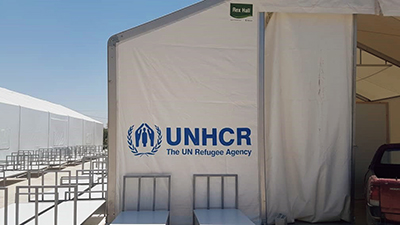 Newly established quarantine facility (Syria; Photo: UNHCR)
Newly established quarantine facility (Syria; Photo: UNHCR)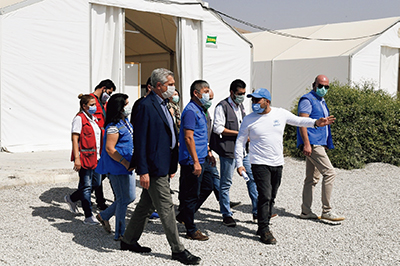 The author (on the right of Mr. Grandi) introducing the quarantine facility to the United Nations High Commissioner for Refugees, Mr. Filippo Grandi (center front) (Syria; Photo: UNHCR)
The author (on the right of Mr. Grandi) introducing the quarantine facility to the United Nations High Commissioner for Refugees, Mr. Filippo Grandi (center front) (Syria; Photo: UNHCR)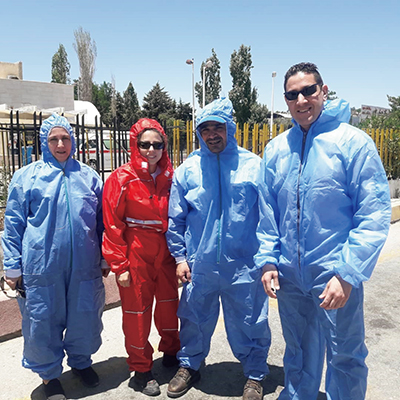 Staff of UNHCR and partner organizations preparing to receive Syrian repatriates at the quarantine facility (Syria; Photo: UNHCR)
Staff of UNHCR and partner organizations preparing to receive Syrian repatriates at the quarantine facility (Syria; Photo: UNHCR)Humanitarian aid to internally displaced persons in Myanmar during the COVID-19 pandemic
Ono Kyoko, Head of Rakhine Office, United Nations Office for the Coordination of
Humanitarian Affairs (OCHA)
In Rakhine State, located in the western part of Myanmar, there are approximately 230,000 internally displaced persons needing humanitarian aid in areas such as food, health care, water, and education from UN organizations and NGOs. The UN Office for the Coordination of Humanitarian Affairs (OCHA), taking on a representative role of more than 40 humanitarian aid organizations such as UNHCR and UNICEF, is responsible for the overall coordination of humanitarian assistance and aid strategies, as well as collaboration and negotiations with the Rakhine State government to ensure that aid is delivered effectively.
Out of the 230,000 internally displaced persons in Rakhine State, about 130,000 are so-called “Rohingya”* people who are Muslims, while the remaining 100,000 are ethnic Rakhine people who are mostly Buddhists. In 2012, the Muslims and ethnic Rakhine people who had been living in harmony until then clashed for religious and political reasons, and the displaced Muslims have been forced to live in camps since then. Many of these people have had their citizenship stripped from them with the amendment of the Citizenship Law in 1982, and the situation has worsened further in the past eight years as they became internally displaced persons. They rely on humanitarian assistance for their survival. On the other hand, many of the ethnic Rakhine people, too, have been living in camps in order to escape from the conflicts that had erupted at the end of 2018, between the armed group known as the Arakan Army whom many Rakhine people support, and the military of the Myanmar government.
Under these circumstances, the situation with the COVID-19 pandemic became increasingly severe in Rakhine State in August. There are concerns of COVID-19 spreading in camps where it is impossible for people to maintain any social distance. To minimize the movement of people, many organizations refrained from entering the camps to provide direct assistance, and relied on remote management of assistance rendered through staff living in the camps. However, as there are limitations to remote assistance activities, very little support has been provided in areas such as education and the reinforcement of infrastructure, where specialized skills are required. Despite the circumstances, we strive to continue providing effective humanitarian aid as we tackle various new challenges every day. Closely working with the international community, the UN is also continuing to engage with the Myanmar government to find a political solution as soon as possible that would allow the internally displaced persons to return to their areas of origin and realize their hopes of living independently.
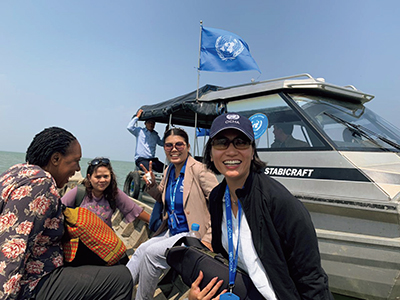 The author (right) and colleagues heading to a camp for internally displaced persons in Pauktaw by an OCHA boat (Photo: OCHA)
The author (right) and colleagues heading to a camp for internally displaced persons in Pauktaw by an OCHA boat (Photo: OCHA)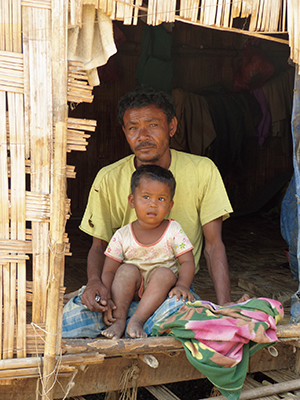 Scene at a camp for internally displaced persons in Sin Tet Maw (Photo: OCHA)
Scene at a camp for internally displaced persons in Sin Tet Maw (Photo: OCHA)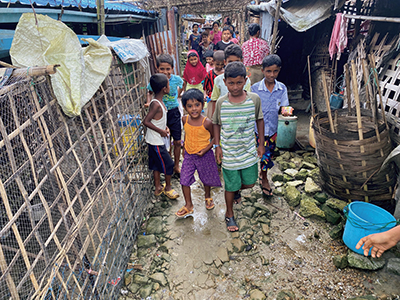 Scene at a camp for internally displaced persons in Kyauk Ta Lone (Photo: OCHA)
Scene at a camp for internally displaced persons in Kyauk Ta Lone (Photo: OCHA)- *The UN uses the term “Rohingya” in recognition of the right of people to self-identity.
(5) Approaches to Appropriate and Effective Implementation of ODA
A Approaches to Appropriate Implementation of ODA
In the implementation of ODA, efforts are made to enhance transparency and quality by listening to the views of external experts at each phase and formulating projects based on these opinions. In the phase of preliminary studies in the implementation of ODA, MOFA holds the Development Project Accountability Committee in public, exchanges views with independent committee members that have knowledge of the relevant field, and affirms the validity of the project. Furthermore, JICA publishes ex-post evaluation results for all projects valued at 200 million Japanese yen or more (2,618 projects published as of the end of January 2021) on the “ODA Mieru-ka Site” after the implementation of the projects in view of enhancing the transparency of the projects. Ex-post evaluations for projects valued at 1 billion Japanese yen or more are conducted by third parties. MOFA conducts third party evaluations at the policy level (such as country assistance evaluations, thematic evaluations and aid modality evaluations) and ex-post evaluations on grant aid projects implemented by MOFA to improve ODA management and ensure accountability. Efforts are made to utilize the lessons drawn from the evaluation results for the policy formulation and project implementation of future ODA. MOFA also publishes the evaluation results on its website.
B Approaches to Effective Implementation of ODA
ODA is implemented through three frameworks corresponding to the needs of the partner country and the scale of the project: grant aid, loan aid and technical cooperation. In order to utilize the limited budget efficiently and achieve a high level of development effectiveness, MOFA formulates a development cooperation policy for each country that defines the priority areas and policies of ODA, taking into account comprehensively the development plans and development challenges of respective partner counties. Moreover, the Rolling Plan is formulated as an appendix to the Country Development Cooperation Policy, with a summary for quick reference on how each individual ODA project is associated with a specific priority area. Through these efforts, the policy of development cooperation in each country is clearly identified, enabling more strategic projects to be formed across the confines of each framework.
C Efforts with regard to International Discussions on ODA
Japan also contributes actively to international discussions on ODA. The OECD/DAC is advancing efforts to modernize ODA, including changing the ODA calculation rules for debt relief and promoting the mobilization of private-sector funds. Japan also strives to ensure that ODA is aligned with the actual situation, and that efforts by donors are reflected accurately.
From 2019 to 2020, DAC Development Co-operation Peer Review for Japan, which is to review policy and implementation of Japan's development cooperation by other DAC members, was conducted for the first time in six years. Through the process, discussions were held on more effective development cooperation. While Japan was highly assessed for its promotion of quality growth and human security in accordance with the Development Cooperation Charter, efforts in addressing global issues, and human resource development cooperation through capacity building, recommendations were made to increase its ODA budget to reach the target of 0.7% of GNI.
D Efforts toward Promoting Understanding of ODA
It is vital to have the understanding and support of the people when implementing development cooperation. To that end, efforts are made to promote understanding among the citizens through the effective dissemination of information. In addition to promotions through events with participants, MOFA is also putting effort into introducing Japan's development cooperation activities around the world in an easy-to-understand manner through the production of the short animation series “Go! ODA-Man” based on the popular anime “Eagle Talon,” and the simulation game “You can be an ODA-Man too!” This short animation series is available to the public through MOFA's YouTube account, and is also broadcast on trains such as Tokyo Metro with the aim of reaching a wide audience. MOFA also dispatches officials to educational institutions and other organizations, and actively conducts “ODA Delivery Lectures” as a part of its efforts to promote understanding of development cooperation, including virtual lectures online in FY2020.
In addition, MOFA makes active efforts in overseas publicity, including plans for tours to its development cooperation project sites for the local media so that they will also cover Japan's cooperation, and issues PR pamphlets and materials in English and local languages.

